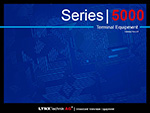Whitepapers
Dynamic conversion for HDR/SDR parallel Production
Abstract
As the number of HDR (High Dynamic Range) productions slowly increases there are a variety of challenges that still exist within HDR productions. Our white paper discusses these challenges and how Dynamic Conversion can help facilities implement parallel HDR/SDR productions.

A Fiber Primer - An Introduction to Fiber Optic Technology
Abstract
Most of us in the Broadcast industry are familiar with fiber optic transmission systems and the solutions widely used for broadcast applications. These are typically external applications for moving video signals between distant locations, or hauling distant camera feeds into outside broadcast units. Signal distribution within a facility is typically copper coaxial cable, which has been used in one form or another since the inception of television. However, with the transition to HDTV video bandwidth increased nearly seven fold from 270Mbit to 1.5Gbit.
With the further migration to 1080P, video bandwidth has increased even further to 3Gbit. As bandwidth increases, the reach of copper cable reduces and our copper connected world is shrinking rapidly.
Cable lengths have been reduced from 350m (1149 feet) at 270Mbit to 140m (460 feet) at 1.5Gbit, and now it’s down to approximately 70m (230 feet) at 3Gbit. If you allow some overhead for cable routing and emergency patch panels etc. then 70m (230 feet) maximum cable lengths imposes serious issues for facility design and expansion.
This paper is a basic introduction to fiber technology as it pertains to the Broadcast and video industry and will explore the technology and explain some of the benefits and potential pitfalls. This also shows some solutions using LYNX Technik fiber interfaces.
The CWDM Fiber Primer - An Introduction to CWDM Fiber Technology
Abstract
Typically, CWDM is a technology used to transport multiple signals between distant locations over single fiber connections. This leverages the utilization and therefore the relative cost of the long distance fiber cable links. However, with HDTV and the increasing bandwidths required for video production (3Gbit) and new 3D markets rapidly evolving (which makes extensive use of 3Gbit SDI in the production environment) we see fiber connectivity increasingly taking the place of traditional copper (electrical) connections within facilities.
As this evolution continues and more and more dedicated unidirectional “point to point” fiber connections are consumed, then an “in house” CWDM solution is the logical next step to better utilize the facilities existing fiber cable assets.
LYNX Control System QuickStart Guide
Abstract
QuickStart Guide to the APPolo Control System. Short step-by-step description of the required initial steps for connection of your first LYNX RackFrame.
Audio technology in the television broadcast studio and the realationship between analog and digital audio levels.
Abstract
With the widespread adoption of digital infrastructures within Broadcast video and audio standards were implemented to ensure seamless equipment interoperability. For the video portion of the signal the transition was fairly straightforward. Strict standards exist for analog video therefore a predictable transition of the video signal into a digital world was possible. The audio transition has been far more complicated.
While published standards exist for digital audio, no standards are in pace for analog audio in terms of nominal audio level, full scale digital audio level and audio headroom. What is used changes by market, geographic location and even application. Audio is still implicitly an analog I/O format. We cannot speak in (or listen to) digital bits, most audio originates in the analog domain and all audio has to be converted back to analog to hear it.
With all the variables and no real standardization for analog audio there is an added layer of complexity which needs to be considered. Managing the A/D and D/A conversion of audio signals is critical to assure optimum audio quality within digital broadcast and Post Production infrastructures.
This white paper will help to understand the issues surrounding the A/D and D/A conversion of audio signals and explore how this relates to “standardized” digital audio methodology (and technology) used in broadcast today.
EBU Digitial A/V Sync and Operational Test Pattern
Abstract
The new EBU A/V sync pattern is unique to the Testor and the new PTG 5610 Test Generator. This is an adaptation of an existing 525 / 625 patterns proposed by the EBU in technical document EBU tech 3305. LYNX Technik has adapted and enhanced this pattern for use in modern multi-format (SDTV and HDTV) environments. The pattern has been designed to address a number of requirements in a modern multi-format digital broadcast facility.




